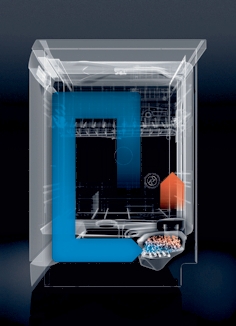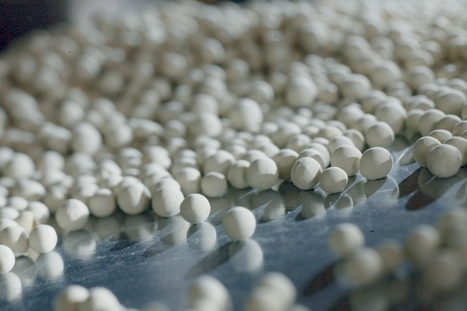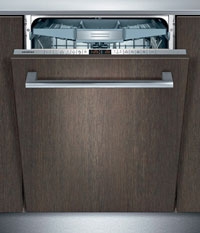
The mantras of energy conservation are beginning to sink in; the many ways that we can save energy around the home have been drummed into us, and we’re becoming wiser about the consequences of profligate energy use. In many cases, it is simply good thrifty sense: switch off lights and appliances when you are not using them, and so on.
But it is tricky to save energy all the time, especially when labour-saving appliances are involved. We are used to having washing machines and dishwashers, but the benefits come at the price of their energy usage. We have to depend on the engineers that design the appliances to come up with ways to shrink their energy consumption.
One innovative way of doing this has been devised by BSH, a joint venture between Bosch and Siemens which develops appliances that are sold under both companies’ brand names. BSH has developed a dishwasher that uses zeolites, a material commonly used in the chemical industries, to reduce the energy usage of a dishwasher by 20 per cent. Sold under the name ’speedMatic’, the dishwasher recently won an innovation award from the German environment ministry.
Zeolites are a form of aluminosilicate mineral which have a highly porous structure. Their crystalline structures are very ordered, with the molecules forming a network of regularly-sized, microscopic holes. This gives the mineral a very high surface area in relation to its volume. Zeolites are often known as molecular sieves, as they are used for their ability to catch and remove unwanted chemicals from streams of gases and liquids in chemical plants. They are also used as water-softeners; they can hold positive ions loosely within their structure and exchange it for other ions in a stream of water.
It’s a different quirk of chemistry that made them ideal for BSH, however, and this comes from the property which made them first catch the attention of chemists. When a zeolite grabs a water molecule - the process known as adsorption - it also releases heat. As the bond between the mineral and water is quite weak, heating the zeolite up again causes the water to be released. This is a property of the chemistry at the zeolite’s surface and, because the surface area is so large, the volume of water the mineral is able to hold is also large - up to 40 per cent of its dry weight.
The speedMatic dishwasher uses this ability to bolster its performance, marking the first time that zeolites have been applied outside industry in a mass-market consumer product.

A chamber containing 1.15kg of zeolite granules sits in a compartment in the dishwasher’s door. During the drying cycle, the fans inside the dishwasher circulate the moist air through the chamber; the zeolite adsorbs the water molecules and releases heat. The hot, dry air emerging from the chamber encourages more evaporation. Even puddles of water caught inside cups and dishes dry up, BSH claims.
During the wash cycle, the heat from the dishwasher’s element drives off the moisture from the granules, regenerating the chamber for the next drying cycle.
“The new zeolite technology provides an enormous increase in efficiency”
KURT-LUDWIG GUTBERLET, BSH
The heat boost that speeds up the drying isn’t free energy - all the heat given out by the zeolite has to be supplied during the wash cycle. But it is an efficient way of spreading the energy use, as the heating element would have to be on to warm the water for the washing cycle in any case.
The dishwasher uses 0.83kWhr of electricity per cycle - some 20 per cent less than the next-most efficient dishwasher currently on sale, according to BSH. It also is also the fastest, with a cleaning cycle of 29 minutes at high temperature (less than two hours for an energy-saving cooler cycle at 50°C, which is still around half an hour less than a conventional dishwasher), and uses less water - 10 litres per cycle compared with 14 litres for a conventional cycle. According to company estimates, an average year’s use will consume some 6,600 litres less water than a conventional dishwasher.

Kurt-Ludwig Gutberlet, head of BSH, said: ’In the last 20 years, we’ve cut our dishwashers’ energy consumption in half. The new zeolite technology provides an enormous increase in efficiency.’
Currently, the speedMatic line represents the top of BSH’s range; the dishwashers retail for upwards of £500. But the company is planning to launch the technology into its mid-price ranges as well, making the benefits available to a greater number of people.
In Depth
Smart Systems
Technology is helping householders to optimise their energy usage
Moving heat around - whether it’s to warm things up or cool them down - requires energy. It’s a simple fact of thermodynamics. But for householders who want to save energy and reduce fuel bills, this can present a problem. One option is to use energy that costs nothing and generates no atmospheric emissions - namely, solar energy.
Solar water-heating systems are surprisingly efficient, even in relatively gloomy climates; Swiss statistics estimate that such systems can generate more than 5kWhrs per square metre of heating panel per day. Pioneered in Israel as a method of getting around fuel shortages, they are now mandatory on all new homes in the state, as they are in Spain.
Ground-source heat pumps are another way of using solar power - they exploit the fact that a short distance below the surface of the soil, the temperature remains constant. Installing coils of piping below the soil and circulating water through them taps that energy. Popular in cooler climates, this is somewhat disruptive (it does, after all, involve digging up the garden) but is now beginning to become more popular in the UK.
Inside the house, things become more complex, but the advent of smart electricity networks is likely to provide more opportunities to trim energy usage. Smart networks provide a method of smoothing out electricity demand, but indoors, home appliances will be able to use them to optimise their power consumption.
For example, if the electricity supplier knows that generation is likely to drop at a certain time, this information can be encoded into the amplitude of transmitted alternating current. This signal would be picked up by the household smart meter and sent to the fridge and freezer via the mains voltage. Having received the information, the appliances would cool down by an extra few degrees before the anticipated power shortage and then turn off their cooling systems, so they warm up gradually (but remain below their optimum operating temperature) and switch back on when power supplies are back up.
Such ’intelligent appliances’ would be seamless in operation; a smart home, which doesn’t depend on the homeowner being smart.
in depth smart systems




Red Bull makes hydrogen fuel cell play with AVL
Formula 1 is an anachronistic anomaly where its only cutting edge is in engine development. The rules prohibit any real innovation and there would be...